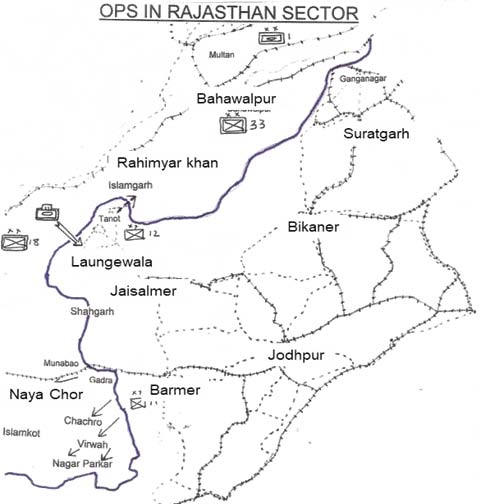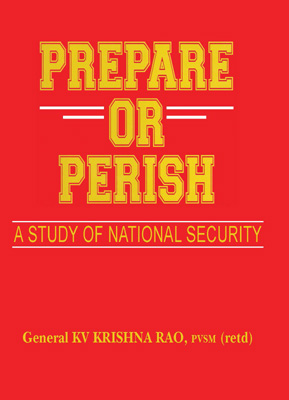
Operations in Rajasthan
The border area of Rajasthan-Sind is generally desert terrain with very limited road and rail communications. The border area of Gujarat and Sind is mainly covered by the Rann of Kutch. The Indian Southern Command was responsible for the defence of the area of Rajasthan and Gujarat, with the exception of the Ganganagar Sector of Rajasthan which was the responsibility of Western Command.
It was expected that Pakistan would mainly remain on the defensive in the Rajasthan-Sind Sector; and may only launch some very limited local offensives, in order to improve their defensive stance. Pakistani 18 Infantry Division was generally responsible for the defence of the area. In addition, 25 Independent Infantry Brigade was responsible for the Bahawalpur area. About 3000 Desert and Indus Rangers were also deployed in the border area, forward of the regular forces. The Pakistani GHQ reserve of 1 Armoured Division and 33 Infantry Division were located in the Multan-Okara area, but it was expected that this force would be mainly used against Western Command. However, in case a serious threat developed in the Sind Sector, it was expected that some small elements of this force may be committed in this Sector.
Pakistan 18 Infantry Division deployed one Infantry Brigade group with a Squadron Armour opposite Jaisalmer Sector, to defend the Khairpur-Rahimayarkhan-Khanpur-Sukkur area. One Infantry Brigade group with a Squadron of Armour was deployed opposite Barmer to defend Gadra-Naya Chor area. The third Brigade of the Division with Regiment plus a Squadron of Armour was in reserve. The area opposite Kutch, i.e., Badin-Virawah area was defended by Para-Military Forces. Equally, desert area opposite Bikaner was also defended by Para-Military Forces.
As far as offensive operations were concerned, it was assessed that Pakistan could muster a force of Division less Brigade and one Armoured Regiment to launch offensive either against Jaisalmer or Barmer. In the Jaisalmer Sector, this was expected to be launched along Rahimayarkhan/Sadiqabad-Kandera-Tanot-Ramgarh-Jaisalmer. In the Barmer Sector, it was expected along Khokhropar-Munabao-Gadra Road-Barmer or Gadra City-Gadra Road-Barmer. In the Bikaner area, due to difficult terrain it was assessed that only raids by Para-Military Forces would be carried out along axis Marot-Rana Bana Toba-Pugal-Bikaner or Yazman Mandi-Ranhal-Ranjitpura-Bikaner. In the Kutch sub-sector, again due to difficult terrain, it was assessed that maximum of a battalion group with Para-Militaiy Forces may be used for the local offensives.
Southern Command under Lt. Gen. G.G. Bewoor, was responsible for operations in the area and an advance Headquarters was set up at Jodhpur for the purpose. The Command had two Infantry Divisions, 11 and 12, for operations in the area. 10 Para Commando battalion was also allotted to the Command. In addition, Kilo Sector was responsible for the defence of Bikaner area; and Kutch Sector was responsible for the defence of the Kutch area. These Sectors of the plains mainly had Para-Military Forces, although 13 Grenadiers, a camel battalion, was allotted to Kilo Sector.
Southern Command planned to initially deploy a Brigade each in the Jaisalmer and Barmer Sectors, to cover the concentration of the remainder of 11 and 12 Infantry Divisions, from cantonments in the rear. Subsequently, the Divisions were to concentrate and were to be prepared to launch offensive operations into Pakistan territory. Accordingly, one Infantry Brigade of 12 Division was deployed in area Kishangarh-Tanot-Sadehwala. One Infantry Brigade of 11 Infantry Division was deployed in the area Munabao-Gadra road.
With regard to offensive operations, 12 Infantry Division under Maj. Gen. Khambata was to advance on axis Kishangarh-Sakhirewalaku-Bhabeya-Rahimyarkhan. 11 Infantry Division under Maj. Gen. R.D.R Anand was to advance to Khokhropar-Gadra City-Naya Chor. 10 Para Commando was to raid Chachro and Badin. Kilo and Kutch Sectors were to carry out some local offensives, eliminate the enemy’s border out posts and improve their defensive posture. The firm bases were occupied by October 26, 1971, and preparations completed by December 3. Once Pakistan struck at the airfields at Jodhpur, Utarlai and Barmer on December 3, 1971, Southern Command was instructed to put its plans into operation.
11 Infantry Division started its operations at last light on December 4. It advanced …from three separate directions and captured Ratok, Relnor and Mankor from the North, Kajlor, Vitala and Khokhropar from the centre, and Gadra City and Khinsar …from the South by the evening of December 5. Construction of a Duck Board track from Munabao to Khokhropar and beyond towards Nayachor commenced immediately, there being no proper road. Incidentally, earlier reports indicated, that a road was available. Concurrently, the railway track, which was destroyed in places, was also being restored. The advance of the Division continued on December 6 and Vasarabh, Sakana and Parche ji Veri were captured by last light December 7.
The screen position opposite Nayachor was pushed back on night December 10/11 and Purbat Ali was contacted. This position was strongly held by the enemy and an outflanking move by Armour was checked. Beyond this lay, the Nayachor defences held by the better part of the Brigade. A deliberate attack was mounted on the Purabat Ali position by the leasing Brigade, and after heavy fighting, was captured in the early hours of December 13. 2 Mahar played a notable part in the fighting. The enemy suffered heavy casualties. He had put in three successive counter attacks, but could not recapture the position.
11 Infantry Division made contact with the Nayachor defences by December 15. Probing attacks were carried out and it was reported that the position was strongly held by the enemy. It came to light that the position was reinforced by a Brigade and an Armoured Regiment from 33 Infantry Division. Concurrent with the operations on the main axis, one brigade of the division advanced in the South and captured Gadra City, .Kinsar, Dali, Chachro and Bagal by December 10. One battalion was ordered to advance oh axis Chachro-Umarkot, to threaten the Nayachor defences from the South. The battalion captured Hingo Thar about 7 km East of Umarkot on December 16, but fell back on being counter attacked on December 1 7.
In the North, 17 Grenadiers took over some of the captured areas and protected the approaches to Miajar, although originally it was to advance on axis Relnor-Nayachor. The Division could net mount an attack on Nayachor, due to the ceasefire on December 17. it must be said to the credit of this division that despite the extremely difficult nature of the terrain which was devoid of communications and the hazards involved, the Division had advanced fairly deep into enemy territory and posed a serious threat to the main enemy defences at Nayachor. Towards the later stages, the Division was reinforced by a Brigade from 12 Infantry Division, but with the logistical problems involved and the limitations of time, it could not be utilized.
As far as 12 Infantry Division was concerned, its operations also started on the evening of December 4. The leading formation captured Sakhirewalakot and Islamkot on the night of December 4/5. On the morning of December 5, a company of 23 Punjab deployed in the area of Longewala reported some tank movement opposite its area. Subsequently, air observation post of the Division reported an enemy Armoured column 20 km long on track Kharotar-Masiliwali Bhid-Ghabbar. The Pakistani column came quite close to the Longewala post and shelled it heavily. The isolated company of 23 Punjab was in a precarious position but held on to its defences in a most gallant manner. The Divisional Commander called for immediate air strikes by the Indian Air Force on the enemy. 11 air strike missions were flown by the Air Force from first light onwards and heavy casualties inflicted on Pakistani Armour, vehicles and troops.
The enemy plans for advance to Jaisalmer via Ramgarh were completely frustrated by the Air Force. The Indian Air Force covered itself with glory in breaking up the enemy advance, which could have resulted in a serious reverse to the Indians in this area. As a result of the enemy action, the Army Commander decided to give up his plans for the offensive in this’ Sector and instead go on the defensive and consolidate the position. 12 Infantry Division launched counter attacks on December 8 and cleared the enemy from Kharotar by the evening. Sarkari Ka Tibba was captured by the evening of December 9. Thus, the entire area was cleared of the enemy. In fact, it came to light later, that the enemy had withdrawn from the area to his main defences. One infantry brigade of the division was sent to the 11 Infantry Divisional Sector, to reinforce its operations.
10 Para Commando raided Chachro on December 7 and took a number of prisoners. Birawah was raided on December 8 and some prisoners captured from here also. An ambush was laid on the track to Mithi, West of Islamkot, and a number of enemy were killed or captured. The raid- on Badin originally planned was, however, not carried out. Over all, the battalion’s operations proved to be useful.
In the Kilo Sector, 13 Grenadiers captured Ranhal on December 6, Salamsar and Rukanwala on December 7, Bijnot on December 11 and Boreh Ka Tibba on December 17. In the Kutch Sector, Nagar Parkar, Virabah and Vingoor were captured on December 8 and Wunggi on December 11.
This was the first time that major operations were undertaken in desert terrain. Considering the difficulties and. hazards involved, the achievements of the troops were reasonable. 11 Infantry Division carried out a fairly deep advance into enemy terrain in the Barmer Sector. The Indian Air Force played the major role in blunting the enemy offensive in the Jaisalmer Sector. These operations showed that there is considerable potential for mobile operations in desert terrain and that the desert could no longer be ignored as was done in the past. They also provided valuable experience to the Indian troops.






93 OOO DARPOOK-Surrendered p@@k foj.